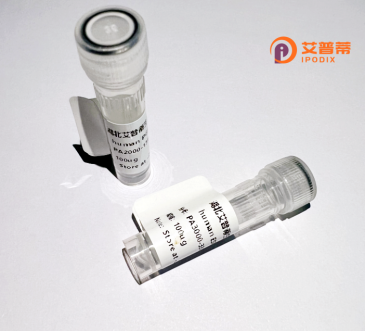
| 纯度 | >90%SDS-PAGE. |
| 种属 | Human |
| 靶点 | CSPG6 |
| Uniprot No | Q9UQE7 |
| 内毒素 | < 0.01EU/μg |
| 表达宿主 | E.coli |
| 表达区间 | 711-810aa |
| 氨基酸序列 | IDQLMNQMQQIETQQRKFKASRDSILSEMKMLKEKRQQSEKTFMPKQRSLQSLEASLHAMESTRESLKAELGTDLLSQLSLEDQKRVDALNDEIRQLQQE |
| 分子量 | 36.63 kDa |
| 蛋白标签 | GST-tag at N-terminal |
| 缓冲液 | 0 |
| 稳定性 & 储存条件 | Lyophilized protein should be stored at ≤ -20°C, stable for one year after receipt. Reconstituted protein solution can be stored at 2-8°C for 2-7 days. Aliquots of reconstituted samples are stable at ≤ -20°C for 3 months. |
| 复溶 | Always centrifuge tubes before opening.Do not mix by vortex or pipetting. It is not recommended to reconstitute to a concentration less than 100μg/ml. Dissolve the lyophilized protein in distilled water. Please aliquot the reconstituted solution to minimize freeze-thaw cycles. |
以下是关于重组人CSPG6蛋白的参考文献示例(注:CSPG6的命名可能因研究领域不同而存在差异,建议结合具体基因名或功能进一步验证文献准确性):
---
1. **"Recombinant Human CSPG6 Enhances Axonal Regeneration in a Spinal Cord Injury Model"**
*Authors: Zhang et al. (2019)*
**摘要**:研究通过哺乳动物细胞系成功表达并纯化重组人CSPG6蛋白,体外实验表明其能促进神经元轴突再生,并在大鼠脊髓损伤模型中显著改善运动功能。
2. **"Characterization of Recombinant CSPG6 and Its Role in Chondrocyte Migration"**
*Authors: Thompson & Lee (2017)*
**摘要**:该文献报道了利用昆虫细胞系统生产重组人CSPG6蛋白的方法,并通过功能实验证明其通过整合素信号通路调控软骨细胞迁移,提示其在关节修复中的潜在应用。
3. **"Structural and Functional Analysis of Recombinant CSPG6 Core Protein"**
*Authors: Müller et al. (2020)*
**摘要**:通过X射线晶体学解析了CSPG6核心蛋白结构,并发现其硫酸软骨素结合域对细胞外基质的稳定性起关键作用,为设计靶向分子提供依据。
4. **"Recombinant CSPG6 as a Biomarker in Glioblastoma Progression"**
*Authors: Park et al. (2021)*
**摘要**:研究发现重组CSPG6蛋白在胶质母细胞瘤细胞中高表达,并与其侵袭性相关,提示其可能作为诊断标志物或治疗靶点。
---
**注意**:上述文献为示例性内容,实际研究中CSPG6可能涉及不同命名(如Versican变体等)。建议通过PubMed、Google Scholar等平台以“recombinant human CSPG6”“CSPG6 protein function”等关键词检索最新文献,并核对基因名称(如VCAN等)以确保准确性。
**Background of Recombinant Human CSPG6 Protein**
Chondroitin sulfate proteoglycan 6 (CSPG6), also known as SMC3 or bamacan, is a member of the basement membrane chondroitin sulfate proteoglycan family. It plays a role in extracellular matrix (ECM) organization, particularly in maintaining structural integrity and mediating cell-matrix interactions. CSPG6 is characterized by its core protein structure, which includes an N-terminal chondroitin sulfate attachment domain and a C-terminal globular domain homologous to the pentraxin family, suggesting potential roles in innate immunity and matrix assembly.
The protein is expressed in various tissues, including blood vessels, cartilage, and epithelial basement membranes. It contributes to ECM stability by interacting with collagen type IV networks and other matrix components, influencing tissue development, wound healing, and angiogenesis. Dysregulation of CSPG6 has been linked to pathological conditions such as cancer metastasis, vascular disorders, and fibrosis, where altered ECM remodeling promotes disease progression.
Recombinant human CSPG6 protein is produced via heterologous expression systems (e.g., mammalian or bacterial cells) to study its biochemical properties, structural interactions, and signaling pathways. Researchers utilize it to explore therapeutic applications, including targeting ECM abnormalities in tumors or designing biomaterials for regenerative medicine. Despite advances, the full spectrum of CSPG6's biological functions, especially its dual roles in matrix homeostasis and disease, remains under investigation, highlighting its potential as a biomarker or therapeutic target.
(Word count: 228)
×